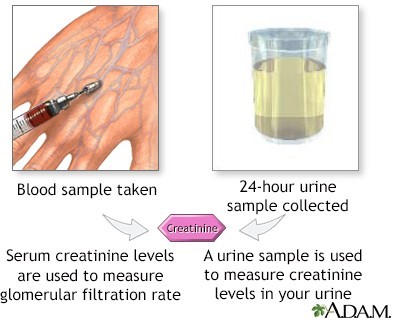Before administering an antibiotic that can cause nephrotoxicity, which laboratory value is most important for the practical nurse (PN) to review?
Serum calcium
Serum creatinine
Hemoglobin and Hematocrit
White blood cell count (WBC)
The Correct Answer is B
Serum creatinine is the most important laboratory value to review before administering an antibiotic that can cause nephrotoxicity. Nephrotoxicity is an alteration in the function of the kidney due to exposure to certain drugs or toxins.
It can be assessed by measuring the glomerular filtration rate (GFR), which is the rate of clearance of a substance from the blood by the kidneys. Serum creatinine is a waste product of muscle metabolism that is freely filtered by the glomeruli and not reabsorbed or secreted by the tubules.
Therefore, it is a reliable indicator of GFR and renal function. An increase in serum creatinine indicates a decrease in GFR and renal function, which may be caused by nephrotoxic drugs.
The other laboratory values are not directly related to nephrotoxicity or GFR:
- Serum calcium: This may be affected by renal function, but it is not a sensitive or specific marker of nephrotoxicity. It may be altered by other factors such as vitamin D, parathyroid hormone, and bone metabolism.
- Hemoglobin and hematocrit: These may be affected by renal function, but they are not sensitive or specific markers of nephrotoxicity. They may reflect the erythropoietin production by the kidneys, which stimulates red blood cell production in the bone marrow. However, they may also be influenced by other factors such as blood loss, hydration status, and iron deficiency.
- White blood cell count (WBC): This is not related to nephrotoxicity or GFR. It may reflect the presence of infection or inflammation, which may be a cause or a consequence of renal impairment, but it is not a direct measure of renal function.

Nursing Test Bank
Naxlex Comprehensive Predictor Exams
Related Questions
Correct Answer is C
Explanation
Choice A rationale:
Procuring platelet products from the blood bank is a task that should be performed by a licensed nurse, not an unlicensed assistive personnel (UAP). It involves assessing the client's needs, verifying orders, and administering the product, which require nursing judgment and skills.
Choice B rationale:
Titrating oxygen to prescribed parameters is a nursing task that requires clinical judgment, especially if the client's condition changes. UAPs do not have the training or scope of practice to adjust oxygen levels. This task should be assigned to a licensed nurse.
Choice D rationale:
Inserting a urinary catheter, even for an uncomplicated client, is a task that should be performed by a licensed nurse. It involves the potential risk of infection and injury, and it requires sterile technique and assessment of the client's condition. UAPs do not have the training or scope of practice to insert urinary catheters.
Correct Answer is C
Explanation
Choice A rationale:
Domestic violence assistance is an important topic, but it falls under secondary and tertiary prevention rather than primary disease prevention, which is the focus of this community outreach program. Primary prevention aims to prevent the disease from occurring in the first place, while domestic violence assistance addresses an existing issue.
Choice B rationale:
Blood pressure screening is valuable for early detection of hypertension, but it also falls under secondary prevention. Primary prevention focuses on preventing the onset of diseases through measures such as immunizations, health education, and lifestyle modifications.
Choice D rationale:
Outreach for support group information is essential for clients with chronic conditions or specific needs. However, it is not primarily related to preventing diseases at the population level, which is the primary goal of this community outreach program. This topic may be more relevant to secondary and tertiary prevention efforts.
Whether you are a student looking to ace your exams or a practicing nurse seeking to enhance your expertise , our nursing education contents will empower you with the confidence and competence to make a difference in the lives of patients and become a respected leader in the healthcare field.
Visit Naxlex, invest in your future and unlock endless possibilities with our unparalleled nursing education contents today
Report Wrong Answer on the Current Question
Do you disagree with the answer? If yes, what is your expected answer? Explain.
Kindly be descriptive with the issue you are facing.
